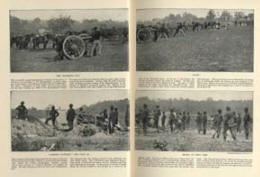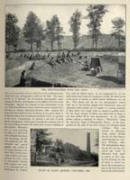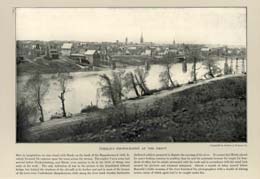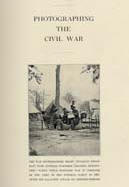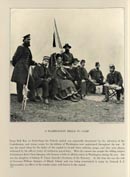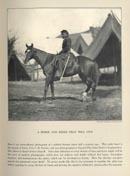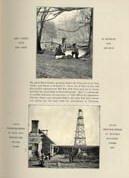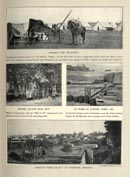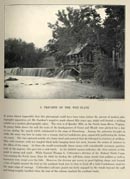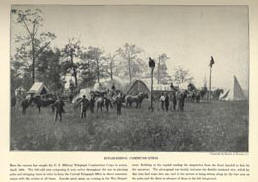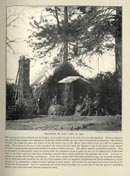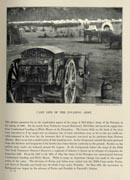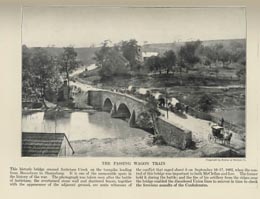Civil War Photography
![]()
This Site:
PHOTOGRAPHING THE CIVIL WAR[Back to Civil War Pictures] By HENRY WYSHAM LANIER,
* There have been, of course, only two wars of this description in the 1800's: the Franco-Prussian War was, for some reason, not followed by camera men; and the marvelously expert photographers who flocked to the struggles between Russia and Japan were not given any chance by the Japanese authorities to make anything like an adequate record. Here is a much more important historical fact than the casual reader realizes. The earliest records we have of the human race are purely pictorial. History, even of the most shadowy and legendary sort, goes back hardly more than ten thousand years. But in recent years there have been recovered in certain caves of France scratched and carved bone weapons and rough wall-paintings which tell us some dramatic events in the lives of men who lived probably a hundred thousand years before the earliest of those seven strata of ancient Troy, which indefatigable archeologists have exposed to the wondering gaze of the modern world. The picture came long before the written record; nearly all our knowledge of ancient Babylonia and Assyria is gleaned from the details left by some picturemaker. And it is still infinitely more effective an appeal. How impossible it is for the average person to get any clear idea of the great struggles which altered the destinies of nations and which occupy so large a portion of world history! How can a man today really understand the siege of Troy, the battles of Thermopylae or Salamis, Hannibal's crossing of the Alps, the famous fight at Tours when Charles "the Hammer" checked the Saracens, the Norman conquest of England, the Hundred Years' or Thirty Years' Wars, even our own seven-year struggle for liberty, without any firsthand picture-aids to start the imagination? Take the comparatively modern Napoleonic wars where, moreover, there is an exceptional wealth of paintings, drawings, prints, and lithographs by contemporary men: in most cases the effect is simply one of keen disappointment at the painfully evident fact that most of these worthy artists never saw a battle or a camp. Photography at the Siege of Petersburg
Cooper's BatteryTo apply this pictorial principle, let us look at one remarkable photograph, Cooper's Battery in front of the Avery house, during the siege of Petersburg, of which we have, by a lucky chance, an account from one of the men in the scene. The lifelikeness of the picture is beyond praise: one cannot help living through this tense moment with these men of long ago, and one's eyes instinctively follow their fixed gaze toward the lines of the foe. This picture was shown to Lieutenant James A. Gardner (of Battery B, First Pennsylvania Light Artillery), who immediately named half a dozen of the figures, adding details of the most intimate interest: I am, even at this late day, able to pick out and recognize a very large number of the members of our battery, as shown in this photograph. Our battery (familiarly known as Cooper's Battery) belonged to the Fifth Corps, then commanded by Gen. G. K. Warren.
Instances might be multiplied indefinitely, but here is one more evidence of the quality of this pictorial record. The same narrator had from Brady a tale of a picture made a year and a half later, at the battle of Fredericksburg. He says: Burnside, then in command of the Army of the Potomac, was preparing to cross the Rappahannock, and Longstreet and Jackson, commanding the Confederate forces, were fortifying the hills back of the right bank of that river. Brady, desiring as usual to be in the thick of things, undertook to make some pictures from the left bank. He placed cameras in position and got his men to work, but suddenly found himself taking a part very different from that of a non-combatant. In the bright sunshine his bulky cameras gleamed like guns, and the Confederate marksmen thought that a battery was being placed in position. They promptly opened fire, and Brady found himself the target for a good many bullets. It was only his phenomenal good luck that allowed him to escape without injury either to himself and men or to his apparatus. Mathew Brady's Photograph of Fredericksburg . . . Taken Under FireIt is clearly worth while to study for a few moments this man Brady, who was so ready to risk his life for the idea by which he was obsessed. While the war soon developed far beyond what he or any other one man could possibly have compassed, so that he is probably directly responsible for only a fraction of the whole vast collection of pictures on this site, he may fairly be said to have fathered the movement; and his daring and success undoubtedly stimulated and inspired the small army of men all over the war-region, whose unrelated work has been laboriously gathered together. Mathew Brady BiographyMatthew B. Brady was born at Cork, Ireland (not in New Hampshire, as is generally stated) about 1823. Arriving in New York as a boy, he got a job in the great establishment of A. T. Stewart, first of the merchant princes of that day. The youngster's good qualities were so conspicuous that his large-minded employer made it possible for him to take a trip abroad at the age of fifteen, under the charge of S. F. B. Morse, who was then laboring at his epoch-making development of the telegraph. Naturally enough, this scientist took his young companion to the laboratory of the already famous Daguerre, whose arduous experiments in making pictures by sunlight were just approaching fruition; and the wonderful discovery which young Brady's receptive eyes then beheld was destined to determine his whole life-work. For that very year (1839) Daguerre made his "daguerreotype " known to the world; and Brady's keen interest was intensified when, in 1840, on his own side of the ocean, Professor Draper produced the first photographic portrait the world had yet seen, a likeness of his sister, which required the amazingly short exposure of only ninety seconds! Brady's natural business-sense and his mercantile training showed him the chance for a career which this new invention opened, and it was but a short time before he had a gallery on Broadway and was well launched upon the new trade of furnishing daguerreotype portraits to all comers. He was successful from the start; in 1851 his work took a prize at the London World's Fair; about the same time he opened an office in Washington; in the fifties he brought over Alexander Gardner, an expert in the new revolutionary wet-plate process, which gave a negative furnishing many prints instead of one unduplicatable original; and in the twenty years between his start and the Civil War he became the fashionable photographer of his day—as is evidenced not only by the superb collection of notable people whose portraits he gathered together, but by Brete Harte's classic verse (from "Her Letter"):
Upon this sunny period of prosperity the Civil War broke in 1861. Brady had made portraits of scores of the men who leaped into still greater prominence as leaders in the terrible struggle, and his vigorous enthusiasm saw in this fierce drama an opportunity to win ever brighter laurels. His energy and his acquaintance with men in authority overcame every obstacle, and he succeeded in interesting President Lincoln, Secretary Stanton, General Grant, and Allan Pinkerton to such an extent that he obtained the protection of the Secret Service, and permits to make photographs at the front. Everything had to be done at his own expense, but with entire confidence he equipped his men, and set out himself as well, giving instructions to guard against breakage by making two negatives of everything, and infusing into all his own ambition to astonish the world by this unheardof feat. The need for such permits appears in a "home letter " from E. T. Whitney, a war photographer whose negatives, unfortunately, have been destroyed. This letter, dated March 13. 1862. states that the day before "all photographing has been stopped by general orders from headquarters." Owing to ignorance of this order on the part of the guard at the bridge, Whitney was allowed to reach the Army of the Potomac, where he made application to General McClellan for a special pass. We shall get some more glimpses presently of these adventurous souls in action. But, as already hinted, extraordinary as were the results of Brady's impetuous vigor, he was but one of many in the great work of picturing the war. Three-fourths of the scenes with the Army of the Potomac were made by Gardner. Thomas G. Roche was an indefatigable worker in the armies' train. Captain A. J. Russell, detached as official cameraman for the War Department, obtained many invaluable pictures illustrating the military railroading and construction work of the Army of the Potomac, which were hurried straightway to Secretary Stanton at Washington. Sam A. Cooley was attached to the Tenth Army Corps, and recorded the happenings around Savannah, Fort McAllister, Jacksonville, St. Augustine, Beaufort, and Charleston during the bombardment; George M. Barnard, under the supervision of General O. M. Poe (then Captain in the Engineer Corps) , did yeoman's service around Atlanta. S. R. Siebert was very busy indeed at Charleston in 1865. Cook of Charleston, Edwards of New Orleans, and other unknown men on the Confederate side, working under even greater difficulties (Cook, for instance, had to secure his chemicals from Anthony in New York—who also supplied Brady —and smuggle them through), did their part in the vast labor; and many another unknown, including the makers of the little cartes de visite, contributed to the panorama which today unfolds itself before the reader. A. D. Lytle . . . Confederate Spy PhotographerOne most interesting cameraman of unique kind was A. D. Lytle, of Baton Rouge, Louisiana, who made a series of views (covering three years and several campaigns—and consequently scattered through the present work) for the specific use of the Confederate Secret Service. That is to say, he was a "camera spy," and a good one, too. He secured his chemicals from the same great firm of Anthony & Co., in New York, but instead of running the blockade with them, they were supplied on "orders to trade." In many cases, for instance, the necessary iodides and bromides masqueraded as quinine.* Mr. Lytle's son relates that his father used to signal with flag and lantern from the observation tower on the top of the ruins of the Baton Rouge capitol to Scott's Bluff, whence the messages were relayed to the Confederates near New Orleans; but he found this provided such a tempting target for the Federal sharpshooters that he discontinued the practice. * This statement is historically confirmed. Professor Walter L. Fleming, of the University of Louisiana, states he has seen many such orders-to-trade, signed by President Lincoln, but not countersigned by Secretary Stanton. There are contemporary comments on the first crop of war photographs which confirm several points already made. Humphrey's Journal in October, 1861, contained the following : PHOTOGRAPHS OF WAR SERIES
We have seen how far Brady came from "monopolizing " the field. And surely the sum total of achievement is triumphant enough to share among all who had any hand in it. And now let us try to get some idea of the problem which confronted these enthusiasts, and see how they tackled it. Imagine what it must have meant even to get to the scene of action—with cumbersome tent and apparatus, and a couple of hundred glass plates whose breakage meant failure; over unspeakable back-country roads or no roads at all; with the continual chance of being picked off by some scouting sharpshooter or captured through some shift of the armies. The first sight of the queer-looking wagon caused amazement, speculation, derision. "What is it? " became so inevitable a greeting that to this day if one asks a group of soldiers about war-photographs, they will exclaim simultaneously, "Oh, yes, the 'what-is-it' wagon! " It became a familiar sight, yet the novelty of its awkward mystery never quite wore off. Wet Plate PhotographyHaving arrived, and having faced the real perils generally attendant upon reaching the scenes of keenest interest, our camera adventurer was but through the overture of his troubles. The most advanced photography of that day was the wet-plate method, by which the plates had to be coated in the dark (which meant in this case carrying everywhere a smothery, light-proof tent), exposed within five minutes, and developed within five minutes more! For the benefit of amateur members of the craft here are some notes from the veteran photographer, Mr. George G. Rockwood:
Some vivid glimpses of the war-photographers' troubles come also from Mr. J. Pitcher Spencer, who knew the work intimately:
Still further details come from an old soldier and photographic expert, Mr. F. M. Rood:
Fortunately the picture men occasionally immortalized each other as well as the combatants, so that we have a number of intimate glimpses of their life and methods. In one the wagon, chemicals and camera are in the very trenches at Atlanta, and they tell more than pages of description. But, naturally, they cannot show the arduous labor, the narrow escapes, the omnipresent obstacles which could be overcome only by the keenest ardor and determination. The epic of the war-photographer is still to be written. It would compare favorably with the story of many battles. And it does not require much imagination, after viewing the results obtained in the face of such conditions, to get a fair measure of these indomitable workers. Mathew Brady dies Poor and ForgottenThe story of the way in which these pictures have been rescued from obscurity is almost as romantic a tale as that of their making. The net result of Brady's efforts was a collection of over seven thousand pictures (two negatives of each in most cases); and the expenditure involved, estimated at $100,000, ruined him. One set, after undergoing the most extraordinary vicissitudes, finally passed into the Government's possession, where it is now held with a prohibition against its use for commercial purposes. The 25,000 tardily voted to Mr. Brady by Congress did not retrieve his financial fortunes, and he died in the nineties, in a New York hospital, poor and forgotten, save by a few old-time friends. Brady's own negatives passed in the seventies into the possession of Anthony, in default of payment of his bills for photographic supplies. They were kicked about from pillar to post for ten years, until John C. Taylor found them in an attic and bought them; from this they became the back-bone of the Ordway-Rand collection; and in 1895 Brady himself had no idea what had become of them. Many were broken, lost, or destroyed by fire. After passing to various other owners, they were discovered and appreciated by Edward Bailey Eaton, of Hartford, Connecticut, who created the immediate train of events that led to their importance as the nucleus of a collection of many thousand pictures gathered from all over the country to furnish the material for this work. From all sorts of sources, from the Atlantic to the Pacific, from Maine to the Gulf, these hidden treasures have been drawn. Historical societies, Government and State bureaus, librarians, private collectors, military and patriotic organizations, old soldiers and their families have recollected, upon earnest insistence, that they did have such things or once knew of them. Singly and in groups they have come from walls, out of archives, safes, old garrets, often seeing the light of day for the first time in a generation, to join together once more in a pictorial army which daily grew more irresistible as the new arrivals augmented, supplemented, and explained. The superb result is here spread forth and illuminated for posterity. Apart from all the above considerations, these invaluable pictures are well worth attention from the standpoint of pictorial art. We talk a great deal nowadays about the astonishing advances of modern art-photography; and it is quite true that patient investigators have immeasurably increased the range and flexibility of camera methods and results. We now manipulate negatives and print to produce any sort of effect; we print in tint or color, omitting or adding- what we wish; numberless men of artistic capacity are daily "showing how to transmit personal feeling through the intricacies of the mechanical process. But it is just as true as when the cave-man scratched on a bone his recollections of mammoth and reindeer, that the artist will produce work that moves the beholder, no matter how crude may be his implements. Clearly there were artists among these Civil War photographers. Probably this was caused by natural selection. It took ardor and zest for this particular thing above all others to keep a man at it in face of the hardships and disheartening handicaps. In any case, the work speaks for itself. Over and over one is thrilled by a sympathetic realization that the vanished man who pointed the camera at some particular scene, must have felt precisely the same pleasure in a telling composition of landscape, in a lifelike grouping, in a dramatic glimpse of a battery in action, in a genre study of a wounded soldier watched over by a comrade—that we feel to-day and that some seeing eye will respond to generations in the future. This is the true immortality of art. And when the emotions thus aroused center about a struggle which determined the destiny of a great nation, the picture that arouses them takes its proper place as an important factor in that heritage of the past which gives us today increased stature over all past ages, just because we add all their experience to our own.
|
![]()
|
Copyright © 2003-2018 Son of the South. Email us at: paul@sonofthesouth.net.
|
|
|
|
Are you Scared and Confused? Click Here to read My Snake Story, a story of hope and encouragement, to help you face your fears. |
||







